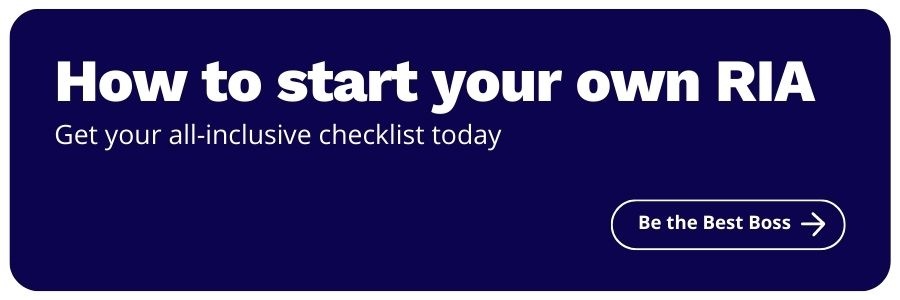Why, When, and How to Transition to Fee-Only Financial Planning: What Would Arlene Say?
Share this
Financial advisors and financial advisor hopefuls often ask why I so strongly advocate for fee-only financial planning. My frame of reference begins by looking at my own history, from an ill-advised whole life policy at the age of 27 (new parents are suckers for a “great” plan to save for college) to a “free” retirement advisor who suggested we put 100% of our money into an annuity a mere two years before we started paying for the first of three college educations.
In both of these all too real scenarios, I was left questioning the motives of the person I had trusted to guide me towards the best financial decisions. Those in need of financial advice shouldn’t have to wonder whether or not their advisor is acting in their best interest—they should be able to fully trust that their advisor is on their side.
This is exactly how many consumers feel, and it’s the key behind fee-only: consumers crave fiduciary, transparent, comprehensive financial advice that will help them live their best lives.
XYPN advisor David Shotwell shared his powerful epiphany about fee-only planning. While learning to use a new planning software, he was thrilled to find a tool that could connect “what a client needed from their portfolio” to his recommendations for how that client “invest the portfolio.” He created templates and presented them to his broker-dealer compliance team:
“When I had the templates set up how I wanted them, I sent them off to the firm’s compliance department. I was sure this was a great idea. Then [the compliance officer], called me to explain why they could not approve my templates. ‘You see,’ he calmly explained, ‘you’re blurring the lines between being an investment advisor, who gets paid to do planning, as a fiduciary, and a registered representative, where products just need to be suitable. If you do a plan like this and then connect that to products, you’re responsible for how the plan works out.’ Now, I knew in the BD world that we could only recommend products that were suitable, but it had never occurred to me that suitability meant that I was not truly responsible for their outcomes. I lived and worked in a small town. I knew these people. Of course I was responsible for my recommendations. How could I make recommendations if I were not willing to stand behind them?
After that conversation, I could never really think about the brokerage world the same.”
Fiduciary fee-for-service financial planners do what is in the best interest of their clients with no ulterior motive(s). As Michael Kitces so accurately explained, “Suitability means selling a suit that fits you. Fiduciary duty means it actually has to look good on you, too.”
Conflicts of interest can be reduced to a bare minimum with fee-for-service planning. You will never eliminate them completely, but at the very least, your clients know you receive no hidden benefit from the services you provide—they know exactly how you get paid.
And that's just one in a long list of benefits of fee-for-service financial planning. Along with transparency into how you are paid, you can anticipate a stability of revenue as you shift from AUM to subscription, retainer, flat fee or hourly. Your fees are tied to your value, not some external factor outside of your control. Your rates don’t change amid market volatility; in fact, your value increases because it’s during times of uncertainty when your clients need you the most.
The fee-for-service model focuses on the relationships an advisor has with their clients, not with their money. As automated investments and artificial intelligence grow and evolve, the personal touch will become increasingly important to those who crave that connection. A pricing structure that brings the focus there will keep clients’ focus there as well.
What's the "Right Time" to Transition to Fee-for-Service?
An advisor recently asked, “When do you make the switch to fee-for-service?” to which I responded, “Any time.” There is no universal right time. But there will always be opportunities to convince yourself you aren’t ready (a global pandemic, for example). Remember, your prospects’ pain points and needs exist whether the market is up or down. As long as you have the resources you need, there is, as they say, no time like the present.
How Do I Make The Shift?
Many advisors transitioning to fee-for-service planning quickly become overwhelmed thinking about compliance and back office operational processes. To get the scoop, I consulted with Scott Gil, XYPN’s senior compliance consultant.
Here’s what he had to say:
Before making the shift to fee-for-service, you should thoroughly read and understand the CFP Board Code of Ethics and Standards of Conduct. In that document, you will find a wealth of information regarding financial planning and investment advisory best practices for fee-only advisors. What’s key, however, is that you understand how to interpret some of the more critical elements of the code. Advisors who plan to center their practice around financial planning models will benefit from a complete and thorough understanding of the entire code. Additionally, if you are a CFP® candidates or current holder of the designation, you will also view this document as comprehensive guidance for how you conduct business.
Scott shared with me that non-CFP® advisors are more likely to have compensation sources from commissions, insurance trails and other sales-related compensation. These advisors have several compensation elements of the fee-only transition to consider. Common areas to note are:
- Solicitation and Referral Arrangements - Many advisors in the transition phase overlook the fact that they cannot be paid by other advisors for referring clients out to them. This can be disappointing if not understood upfront.
- Transparency in working with related parties - The advisor will need to be transparent about any compensation arrangements between their firm, and any outside financial planning, legal, accounting, or business planning service providers they may recommend to their clients.
- Annuity and Insurance Business - Advisors should be prepared to discontinue receiving compensation from commissions and trails from insurance and annuity business. This can mean selling your commission business or contacting insurance couriers to request to have their appointments removed. Ryan Insurance works with FPA and NAPFA members interested in transitioning to fee-only. Here at XY Planning Network, we allow a full year for you to transition to fee-for-service from the date you join, so you can begin using our resources to assist you even when the final commission side of your business is being wrapped up.
Update the messaging on your website to reflect changes. If you are publishing fees on your site, be sure your ADV is updated accordingly.
And what about your clients? How will they take the news of your changing fee structure? Conversations with clients about transitions in fee structure can understandably make advisors nervous. Take a breath and relax. Remember, you are making this change to benefit your clients. I have yet to meet a person who switched to fee-for-service to take advantage of their clients. There is always a story behind the change and it usually involves helping people in a more authentic way. It’s really hard to fault someone for that.
Advisors launching or transitioning to fee-only have asked me if they need new designations. If you are transitioning to fee-for-service, probably not. To be registered, you need a Series 65 or Series 66 and 7; or you must have the CFP®, CFA®, ChFC®, CPA/PFS, or CIC designation in good standing.
If you are new to the industry, a series 65 is a common first step. At XYPN, we strongly recommend becoming a CFP® Professional. You may very well find additional designations that help you with your particular target market. Those can be added as you go or before you launch; it’s a personal choice. Just be sure you have the knowledge you need for those specialized planning needs before you endeavor to start giving advice.
Shifting Your Planning Process to Fee-for-Service
You may be wondering how financial planning itself is different with fee-for-service. It depends. Fee-for-service planning will pull more comprehensive planners, rather than investment focused. Life planning, goals visualization, human capital planning, debt management, education savings, student loan planning, insurance analysis, estate planning review, intensive tax planning and preparation are all areas you may choose to incorporate as a comprehensive fee-for-service planner.
When you transition to fee-for-service planning, you need to think through what the client experience will look like. How do you want the relationship with your clients to look? How do you want your business to operate? Your pricing structure will reflect the answers to these questions. You may enjoy long-term relationships or a steady stream of new challenges. Or perhaps you want a bit of both. Create your service offerings to support those preferences. Do not feel you should do what everyone else is doing. (Should is like a curse word at XYPN.) And definitely don’t feel like you need to be all things to all people. Create the business you want serving who you want the way you want. Doing so will allow you to create the life you want. There are no right or wrong answers here. It is a matter of working through what you want and what you value and creating the model that reflects those wants and values with intentionality and purpose.
Engagement Offerings
Be unwavering here—don’t do what you don’t want to do. Never be afraid to say a certain engagement isn’t appropriate for a client (and don’t be afraid to turn away prospects who clearly aren’t a right fit!). Remember, your purpose is to be a guide for your clients as they navigate their financial lives; if you lead them astray by offering an engagement that isn’t the right fit for them, the consequences fall on you even though they wanted the engagement in the first place.
There are several common levels of engagement. Entry-level may be limited in scope and time. You may offer a full plan and monitoring of that plan or perhaps investments only. The most common offering is a full-service planning and management combination. What you decide is limited only by your imagination. Keep in mind that your engagements can, and most likely will, evolve.
Many newer planners wonder if they have to manage assets. The short answer is no. But it is an option under the fee-for-service model if you want to incorporate investment management into your practice. It is somewhat expected, or at least anticipated. You won’t catch people off guard if you offer to manage their money. Don’t worry about seeming pushy. The biggest reason I see people shift to managing assets is to help ensure their recommendations get implemented. Investment management can help with client retention as it makes the advisor-client relationship stickier (clients are not crazy about moving assets). Not every advisor likes managing investments (which is totally fine), and investment management will take some work on your end. If you decide you want the retention benefit but not the extra work, you can enlist a third-party TAMP like XY Investment Solutions to handle it for you.
Tax preparation services are another great value-add. Like investment management, offering tax preparation helps with client retention. It’s not to be taken on lightly, however. You need to pursue additional education and significant annual continuing education if you are doing it in house. It will impact your annual meeting cadence and scheduling as well. If you want to incorporate tax preparation services into your practice but feel ill-equipped to do so, you can always outsource. XYPN members can enlist the help of XY Tax Solutions to offer tax preparation to their clients without sacrificing their time and energy, which is better spent focusing on the things they enjoy.
How Do I Charge for Fee-for-Service Planning?
Once you’ve decided what you’ll offer, it’s time to choose how you’ll charge for your services.
As far as fee structures go, hourly is pretty straightforward. It is simple for clients to understand. The focus is on your current work and it makes financial planning accessible to everyone. If you like variety and new projects or you like one-time engagements, the hourly structure may be the way to go. The challenge is if you are working to create long-term relationships, in which case, charging on subscription might make more sense. But if you like variety paired with simplicity in pricing, hourly may be your best bet.
Retainer or subscription pricing, regardless of whether you bill clients quarterly or monthly, is a set cost for the client. The subscription model makes planning more broadly accessible as it doesn’t focus exclusively on those with assets. It also helps foster long-term relationship. You won’t be tying your compensation to performance, but rather showing the value of ongoing, comprehensive financial advice. As an added bonus, having a more stable client base will allow you to work less to fill the pipeline and grow the client referrals as your business grows.
AUM is a common fee structure because people get it. It is easy to understand and frankly it just sounds small to quote 1% rather than $3,000 a quarter. It pulls the client’s focus to investments rather than planning. But there is also more chances for conflicts of interest to arise when you’re paid based on assets. Many advisors don’t ever want their clients to wonder whether or not they are acting in their best interest, and for good reason.
The good news is you can have a variety of offerings to create the client base you prefer. Mix and match as you wish. Having a reduced AUM rate on client assets with a fee for planning and other services will show the comprehensive planning process has standalone value and move away from the free-with-purchase mentality of a straight AUM structure. If you serve clients who are still building their wealth and who have more income than assets, but still need advice you may choose an income and net worth combination over AUM.
The best part about building your own business is that it’s yours—YOU are in control. As the shot caller, you get to create the engagements and set the pricing, you get to choose who you work with, and you get to decide the impact you have on the lives of your clients.

About Arlene Moss, Executive Coach
Arlene gets a kick out of helping financial advisors get over being overwhelmed and take on their frustrations so their businesses soar. Arlene works to ensure XYPN members are able to help their clients prosper while creating a sustainable business model. Through XYPN Academy and one-on-one coaching, members get the support they need to grow their businesses and overcome the challenges that come their way.
Share this
- Running Your RIA Efficiently: Outsourcing Bookkeeping with XYPN Books
- Road to Launch with XYPN Member Alan Skillern, CFP®, MBA
- Coaching for Better Time Management: Prioritizing Organic Growth in Your Daily Routine
- Boost Your Financial Advisory Practice: SEO Strategies and CRM Optimization for Sales Success
- Advisor Blog (693)
- Financial Advisors (221)
- Growing an RIA (99)
- Digital Marketing (87)
- Marketing (84)
- Community (81)
- Start an RIA (76)
- Business Development (72)
- Coaching (72)
- Running an RIA (70)
- Compliance (69)
- Client Acquisition (65)
- Technology (64)
- XYPN LIVE (59)
- Entrepreneurship (57)
- Sales (49)
- Practice Management (44)
- Client Engagement (41)
- Bookkeeping (38)
- XYPN Books (38)
- Investment Management (37)
- Fee-only advisor (36)
- Lifestyle, Family, & Personal Finance (31)
- Employee Engagement (30)
- Client Services (25)
- Financial Education & Resources (25)
- Journey Makers (21)
- Market Trends (21)
- Process (14)
- Niche (11)
- SEO (9)
- Scaling an RIA (9)
- Career Change (8)
- Transitioning Your Business (7)
- Partnership (6)
- Transitioning To Fee-Only (4)
- Social Media (3)
- Transitioning Clients (3)
- Emerald (2)
- Persona (2)
- RIA (2)
- Onboarding (1)
- Sapphire (1)
Subscribe by email
You May Also Like
These Related Stories

How to Choose a Support Network as an Independent Financial Advisor: What Would Arlene Say?
Dec 16, 2019
11 min read

Choosing a Financial Planning Fee Structure – What Are the Options?
Feb 11, 2015
13 min read





